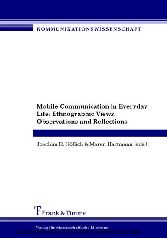Suchen und Finden
Mehr zum Inhalt

Mobile Communication in Everyday Life - Ethnographic Views, Observations and Reflections
Mobile Visuality and Everyday Life in Finland: An Ethnographic Approach to Social Uses of Mobile Image (p. 103-104)
Virpi Oksman
I’m currently waiting, I have two families near to me that both are now having babies through artificial insemination, so I’m waiting from both directions to get an MMS message pretty soon; it’ll be exiting to see which one of them gets there first. And I’ll be sure to feel hurt if I don’t get them. That’s how it’s gotten nowadays. (Valma, 64, grandmother)
In recent years, as camera phones and digital cameras have become more common, sending visual messages has become increasingly easy. Visual communication is used most importantly between members of the immediate circle: MMS creates closeness between friends and family members and adds emotion to the communication; messages are often humorous and they function to maintain and enforce relationships and social bonds. Mobile visual communication has become one means of communication to complement the more traditional ways of keeping contact. For instance the news about the arrival of a baby or a new pet is delivered immediately through MMS, whereas before sending photographs in a letter was perhaps the most commonly used method.
The aim of this article is to observe the uses of visual mobile technology and the social meanings associated with it through an ethnographic research design. The research group at the University of Tampere in Finland has charted developments in the usage of mobile communication and the Internet since 1997. A longitudinal study of many years provides data for the observation of trends in technology use. Between 2002 and 2005 the University of Tampere has been analysing the wishes that users of various age groups have in relation to mobile media, data communication and value-added services. After 2002, the study of MMS communication has become an important aspect of the study. In 2005, field experiments have been carried out with key informants using 3G phones. The experiments are used to provide more detailed information on the usage situations of daily life and the special characteristics of the role of image in mobile data communication.
The research has utilised mainly two different types of ethnographic research design in the context of research on visual mobile communication: 1. field experiments and 2. longitudinal follow-up study of the phenomenon through thematic interviews and observation. The article analyses the types of knowledge that can be produced and the variety of information needs that it can be used for.
Approaching the social uses of mobile images
Mobile visual communication has been studied through several different methods in different countries. Often, research results have been acquired through field experiments where the subjects have received camera phones to use for a certain period of time. In some countries, such as Japan, interviews of camera phone owners have been possible for some years due to the high penetration level of the devices in the country (Okabe, 2004; Ito, 2005). Many empirical studies on mobile image highlight the personal and emotional nature of the communication (see Van House et al., 2004; Okabe, 2003; Koskinen, Kurvinen & Lehtonen, 2000; Kasesniemi et al., 2003; Scifo, 2004). In Japan for instance mobile images are experienced as very private – many say that sharing photos feels more ‘intrusive’ than just sending e-mail messages. Photos are mailed only to intimates such as a lover, a spouse or a very close friend. Decisions about sending an image or what kind of a photo to send are made based on social relationships (Okabe, 2004:10). Van House identified four traditional uses of photos: constructing a personal and group memory; creating and maintaining relationships; and self-presentation. On the basis of camera phone studies, a fifth category was also identified: functional images. From their data, the researchers concluded that camera phone use encourages experimentation with a more expressive use of images (Van House, 2004:3). Kindberg et al. (2005:46) observed in their study that the most common reason for capturing a mobile image was to enrich mutual experience by sharing an image with those who were co-present at the time.
Alle Preise verstehen sich inklusive der gesetzlichen MwSt.








